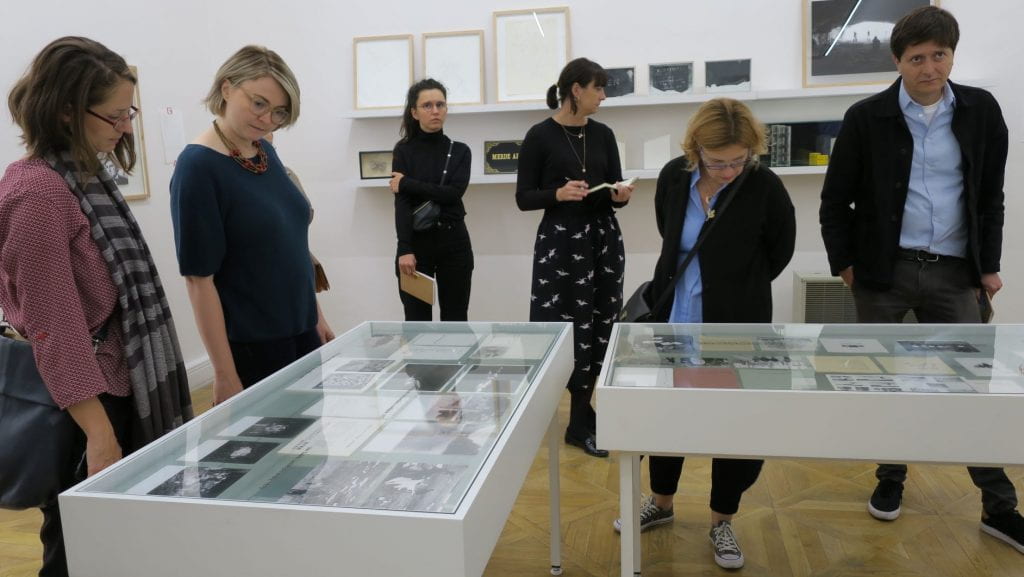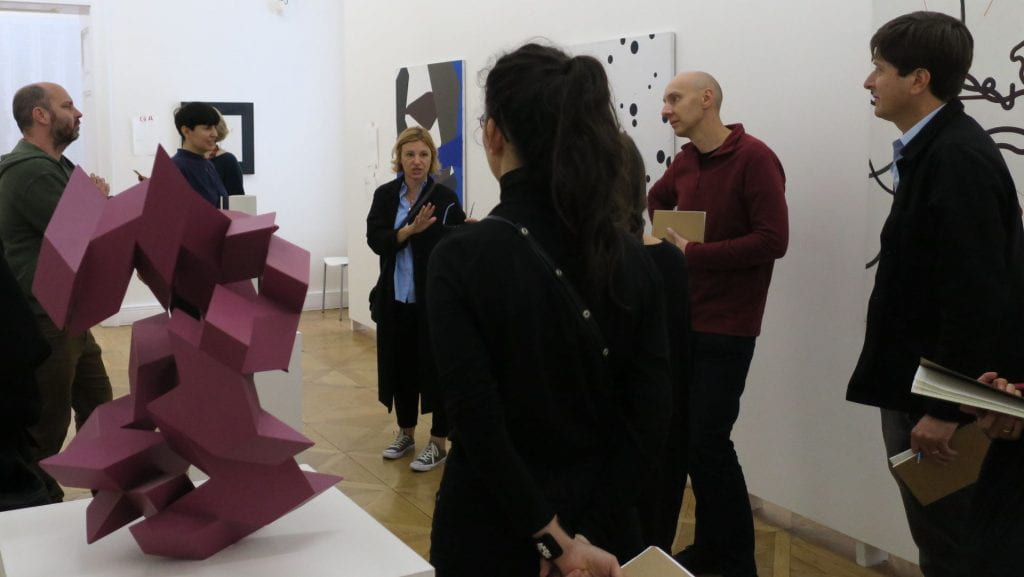
In the middle of Confrontations seminar, on the way between Prague and Bratislava, we spent the whole day in Brno, that turned out to be not just a transit point between Czech and Slovak art scenes, but also an inspiring place to explore some episodes and protagonists of these scenes more closely. ‘Art is Here’ claimed the title of the exhibition at Moravian Gallery in Brno. After the large premises of the Trade Fair Palace, National Gallery in Prague, which even through its architecture revealed the complexities of dealing with the art history of the recent past, the Moravian Gallery in Brno was pleasantly approachable and appealing with unconventional details of the display design. For instance, in the modern and inter-war-avant-garde art section, under each painting, right on the wall is a black and white reproduction of the work in question – so that if works are out of the gallery premises, on loan or restauration, visitors can still see them.

 Most striking was the diversity and uncompromising character of these nonofficial art scenes in spite of political pressure after 1968, and the connections Valoch had with Czech, Slovak and international artists. Each of the exposition rooms maps the different roles Jiří Valoch had – the ones of curator, organizer, artist, theoretician, networker or collector. For me the most telling was the room that introduces Valoch as a collector: a reconstruction of the situation in his flat that is overcrowded with artworks, commenting on Valoch’s very passionate engagement, where the boundaries between life and art are more than blurred.
Most striking was the diversity and uncompromising character of these nonofficial art scenes in spite of political pressure after 1968, and the connections Valoch had with Czech, Slovak and international artists. Each of the exposition rooms maps the different roles Jiří Valoch had – the ones of curator, organizer, artist, theoretician, networker or collector. For me the most telling was the room that introduces Valoch as a collector: a reconstruction of the situation in his flat that is overcrowded with artworks, commenting on Valoch’s very passionate engagement, where the boundaries between life and art are more than blurred.
(Ieva Astahovska)
 The group’s visit to Brno revolved around the figure of the artist, curator, and theoretician Jiří Valoch, who played a central role in the development and promotion of experimental art from the mid-1960s onwards, in Brno itself and also in a broader context. Thanks to the curator Ondřej Chrobák, we were able to see how Valoch’s collection (consisting of documents, artworks and objects) is featured in the new permanent exhibition “ART IS HERE: New Art” at the Moravian Gallery-Prazak Palace. The discussions focused on the display, artists’ strategies to enable interaction in the context of political normalisation in Czechoslovakia, as well as Valoch’s less known facet as an art collector. As he was actively involved both in local organisations such as the Brno House of Arts and in international networks, Valoch’s activities were particularly emblematic of the overlapping or coexistence of the official and unofficial spheres, a subject that was at the heart of the discussions in this second session of Confrontations.
The group’s visit to Brno revolved around the figure of the artist, curator, and theoretician Jiří Valoch, who played a central role in the development and promotion of experimental art from the mid-1960s onwards, in Brno itself and also in a broader context. Thanks to the curator Ondřej Chrobák, we were able to see how Valoch’s collection (consisting of documents, artworks and objects) is featured in the new permanent exhibition “ART IS HERE: New Art” at the Moravian Gallery-Prazak Palace. The discussions focused on the display, artists’ strategies to enable interaction in the context of political normalisation in Czechoslovakia, as well as Valoch’s less known facet as an art collector. As he was actively involved both in local organisations such as the Brno House of Arts and in international networks, Valoch’s activities were particularly emblematic of the overlapping or coexistence of the official and unofficial spheres, a subject that was at the heart of the discussions in this second session of Confrontations.

This was followed by another fascinating visit, this time to the part of the Jiří Valoch Archive that is conserved at the Moravian Gallery’s Governor’s Palace. The curator Jana Písaříková offered us an overview of the large amount of material held at the gallery, reflecting the artist’s connections and interests over more than four decades. One of the challenges the Archive currently faces is the need to design an organizational structure for materials from an artist who was never interested in self-archiving. There is no doubt that the whole complex is fertile ground still to be explored!
(Juliane Debeusscher)

 Close
Close












